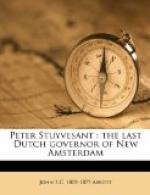They found upon the shore a bleak, barren, treeless waste, “without weeds, grass or timber of any sort to make a fire.” It was bitter cold. A fierce wind swept the ocean and the land, and the sea ran so high that it was expected every moment the ship would go to pieces. These poor emigrants thus suddenly huddled upon the icy land, without food and without shelter, were in imminent peril of perishing from cold and starvation.
Their sufferings were so terrible that they were rejoiced to see some Indians approaching over the wide plains, though they knew not whether the savages would prove hostile or friendly. But the Indians came like brothers, aided them in every way, and dispatched two swift runners across the island to inform Governor Stuyvesant of the calamity. Some sails were brought on shore, with which a temporary shelter from the piercing blast was constructed, and enough food was secured to save from absolute starvation.
The energetic governor immediately dispatched nine or ten lighters to their assistance, and with needful supplies proceeded in person to the scene of the disaster. Thus nearly all the cargo was saved and the passengers were transported to New Amsterdam. There were one hundred and twenty-five passengers on board the Prince Maurice, seventy-six of whom were women and children. Another ship, the Gilded Beaver, was chartered at New Amsterdam which conveyed them all safely, after a five days’ passage, to South river. The other vessels, with soldiers and a few settlers, also soon arrived.
It is said that at this time the “public,” exercises of religion were not allowed to any sects in Holland except the Calvinists. But all others were permitted to engage freely in their worship in private houses, which were in fact, as if public, these places of preaching being spacious and of sufficient size for any assembly. Under this construction of the law every religion was in fact tolerated.[9]
The Lutherans in Holland sent a clergyman, Ernestus Goetwater, to New Amsterdam, to organize a church. The Directors wrote,
“It is our intention to permit every one to have freedom within his own dwelling, to serve God in such manner as his religion requires, but without authorizing any public meetings or conventicles.”
This tolerance, so imperfect in the light of the nineteenth century, was very noble in the dark days of the seventeenth. Upon the arrival of Goetwater at New Amsterdam, the clergy of the Reformed church remonstrated against his being permitted to preach. The governor, adhering to his policy of bigotry, forbade him to hold any meeting, or to do any clerical service, but to regulate his conduct according to the placards of the province against private conventicles. Soon after this the governor ordered him to leave the colony and to return to Holland. This harsh decree was however suspended out of regard to the feeble health of Goetwater.




